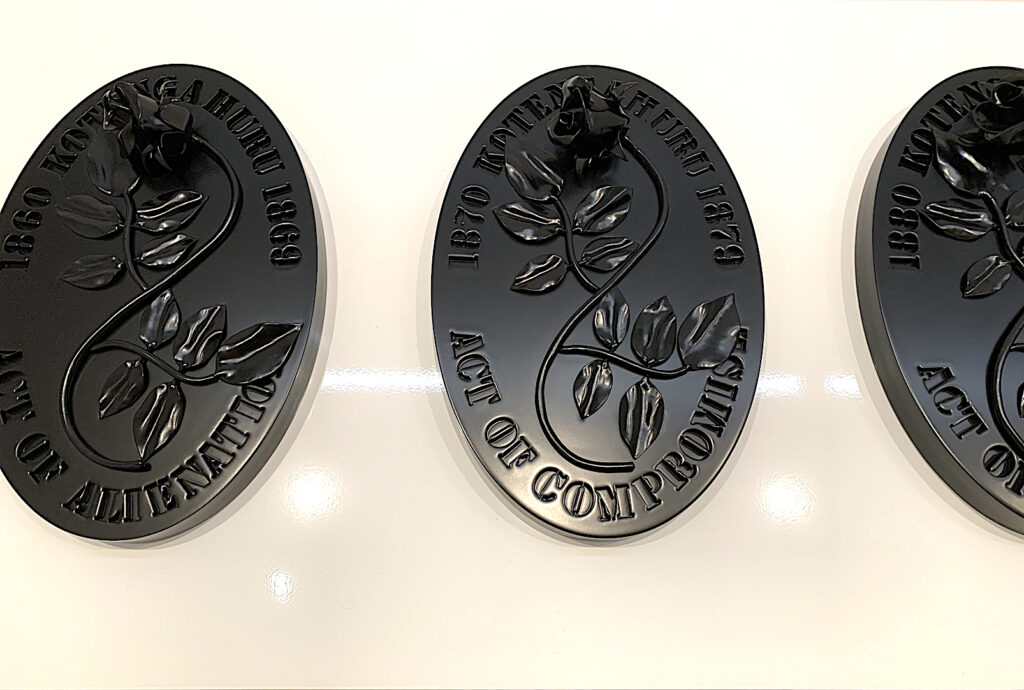Week 2: ‘By Implication – After ‘Atapō’ (Tuesday 9th March). ‘A Weight Off Your Mind’
‘Atapō’ (Personification of Dawn), 2020 Work by Mata Aho Collective & Maureen Lander Toi Tu Toi Ora Exhibition – Auckland Art Gallery
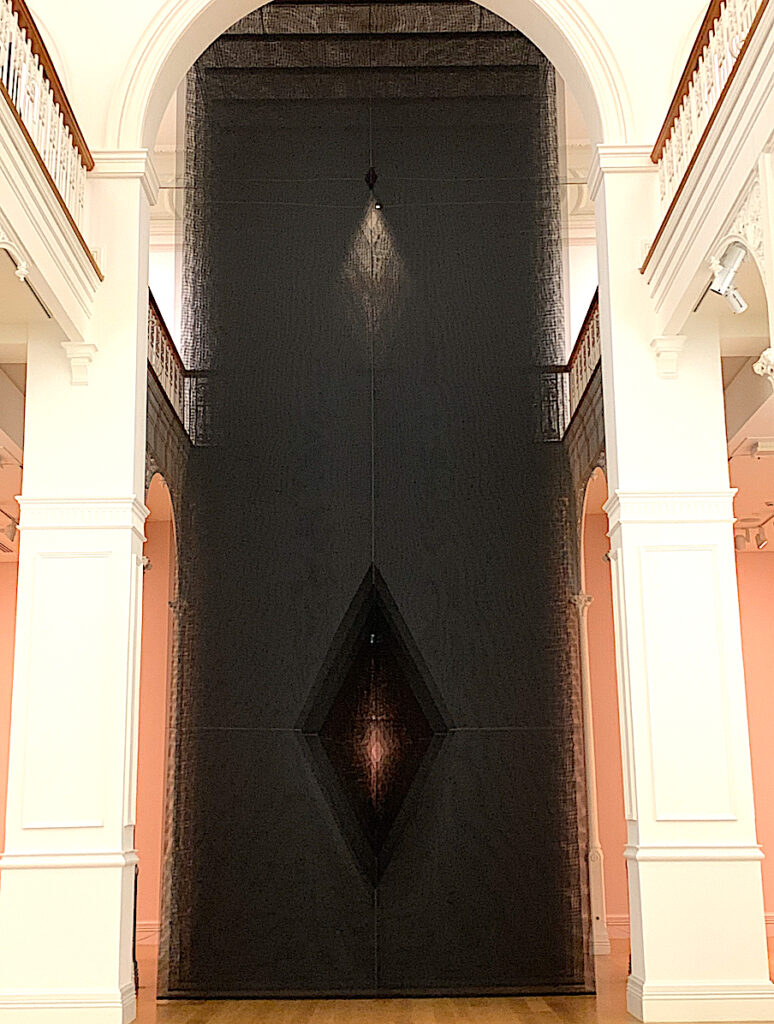
Even though this was my third visit to the ‘Toi Tu Toi Ora’ Exhibition at the Auckland Art Gallery, I found myself still overwhelmed and humbled by the talent, technical skills, beauty and power of the variety of artworks on display. The spotlight lighting is effective beaming on certain objects, like a dancer on the stage, enhancing these contemporary taonga to an almost spiritual realm.
As I arrive in the lower floor of the gallery space, ‘Atapō’ (personification of Dawn) sits bounded between night and day, like a mysterious forest in the distance. My eyes sink into the dark denseness, but then, become distracted and drawn to other powerful objects in the room such as Michael Parekowhai’s large Elephant bookends, and the huge photographs of Lisa Reihana. When I look back at ‘Atapō’ (personification of Dawn), I am drawn forward to explore the mysterious geometric opening, a diamond centrally placed.
From further back, I see a colour contrast between the dark rectangular mass under the gallery’s tent of white wooden archways. Is it a night-time scene of a block of trees? Or the misty black infinite sky of Te Ranginui-e-tū-nei? Perhaps, the volume represents a massive gate or entrance way to an ancient cathedral.
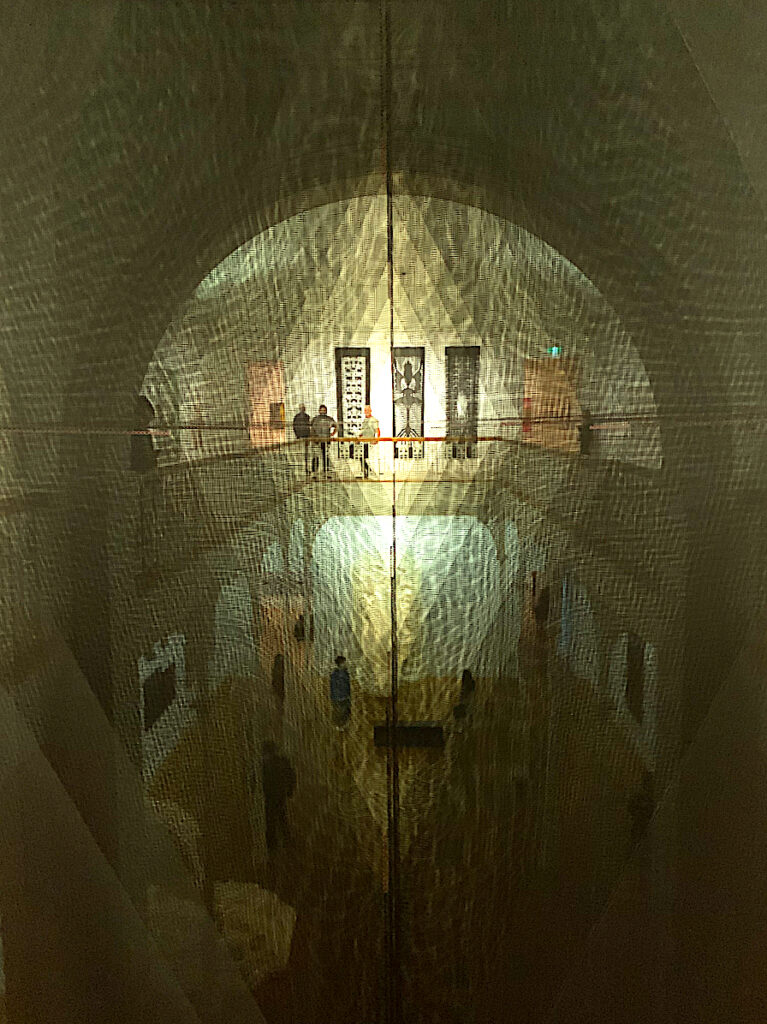
As I get closer I wonder if I can enter the gates through a light filled diamond doorway, and take a downward spiral staircase on a path to the realm of Hine-nui-te-po (Goddess of Death/Souls). I want to feel these sheer, translucent walls and discover the sculptured space beyond the entrance. But the density of the metal-like blind material has fine holes, and appears heavy, because of the repetitive number hanging close-knit in a row. The opening is not a doorway, but a window of repeated diamonds, that reflects like a mirror. It looks like no living soul cannot enter.
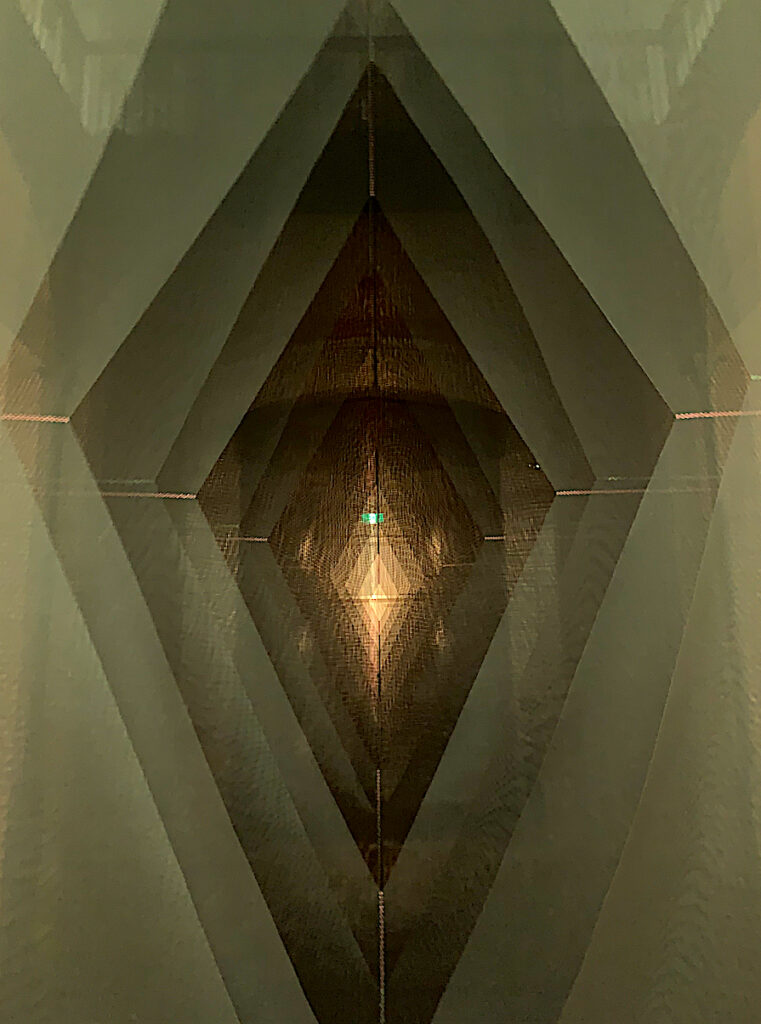
On closer inspection, I see that the material used has a fine woven pattern, not too dissimilar to my factory machine-made black mesh blinds that hang in my home to block out the sun. These large vertical planes (perhaps 6 metres in length, and 3 metres wide) imply a narrative, or layers of concepts, hanging behind each other like trees in a planted forest. The gap between them is too narrow to venture, so you are unable to go into the forest. Instead this transparent castle is too precious to touch, and seems encased inside a glass, black box.
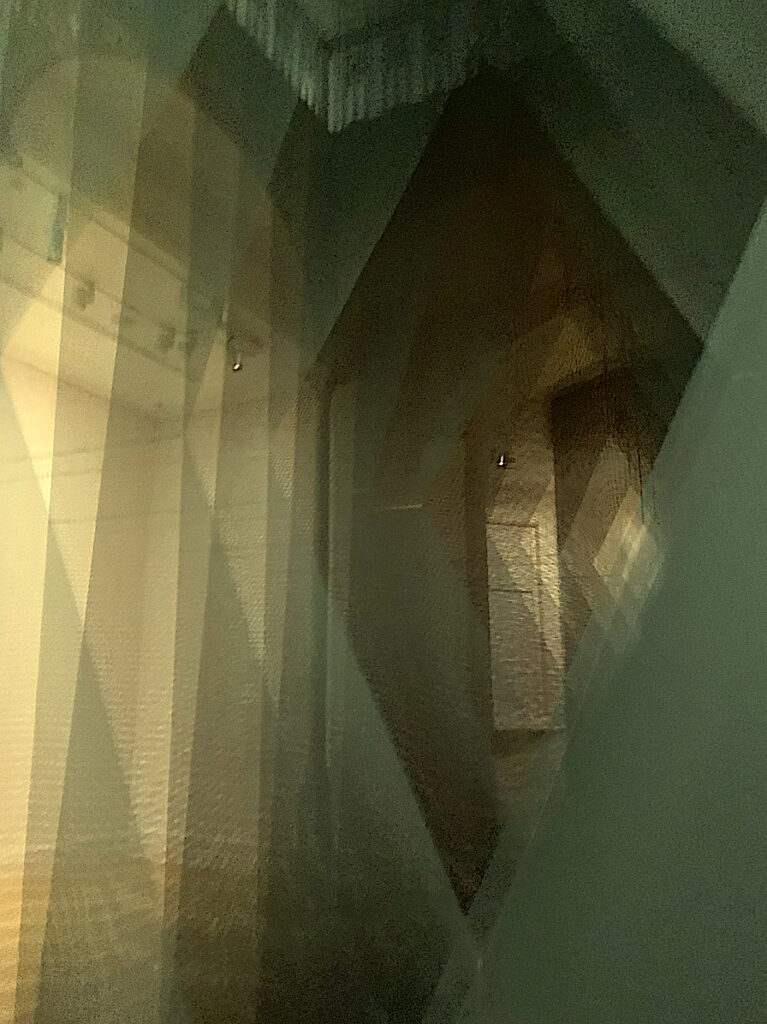
From the front, the straight linear edges block visitors from entering. I examined the centimetre size cross shape detail of fine thread, hand sewn to the mesh in vertical lines. Also, there are soft thread ends dangling from each blind-like frame corner. An intermittent sound of a bird call startles visitors, and I wonder if these small, unwoven coloured threads represent Tane’s birds and insects that will not venture into Hine-nui-te-po’s death forest. Instead they just sit lightly on the edges, in direct contrast with the heaviness of the mass of black mesh hangings.
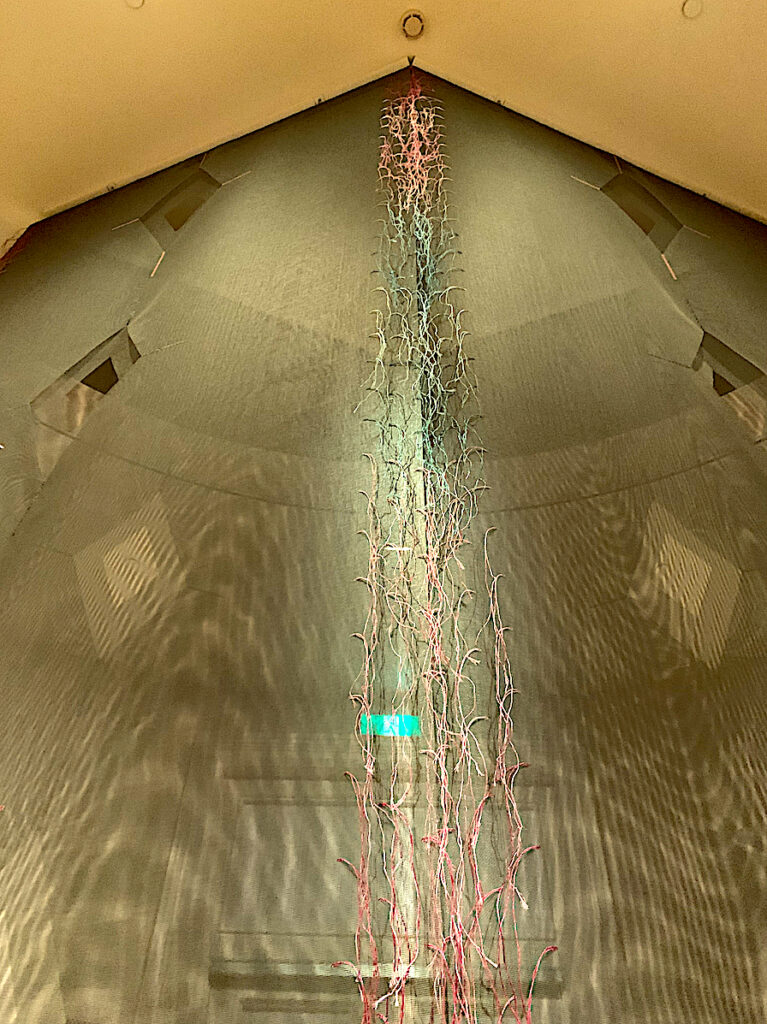
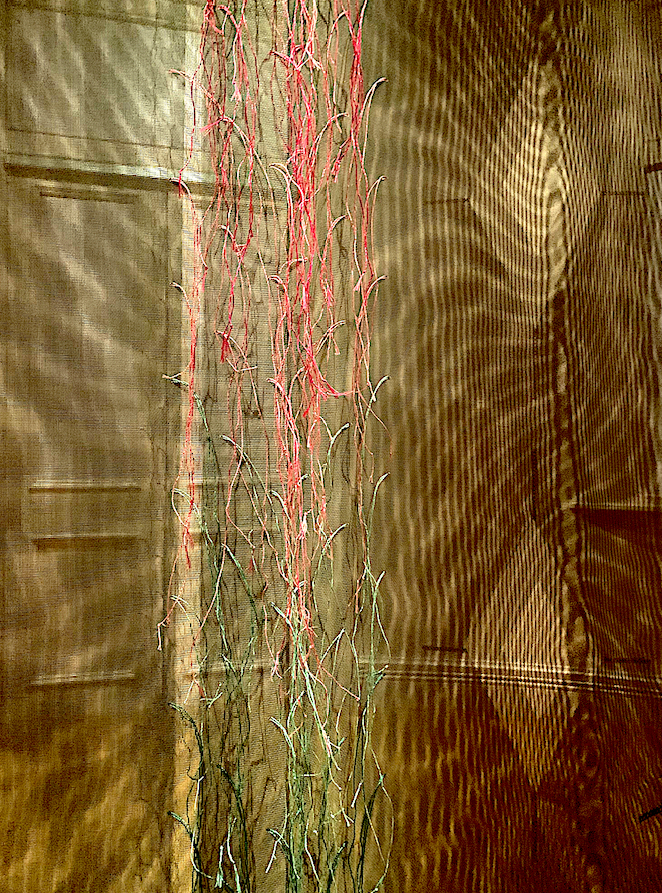
After viewing the installation work from the front and side, I discovered there were other related forms (on the lower gallery space, and another repeated on the higher gallery space) behind the main structure. Thus, the ‘Atapō’ (personification of Dawn) installation comprises of three separate structures. They connect to the major hanging work, by the same use of materials. Differences include height, width size, depth of layers and colour (the mesh was grey, not black). Perhaps these house-like enclosed structures represent the Goddess of Death’s spiritual altar rooms or look-out towers to survey the world of the living through her diamond windows.
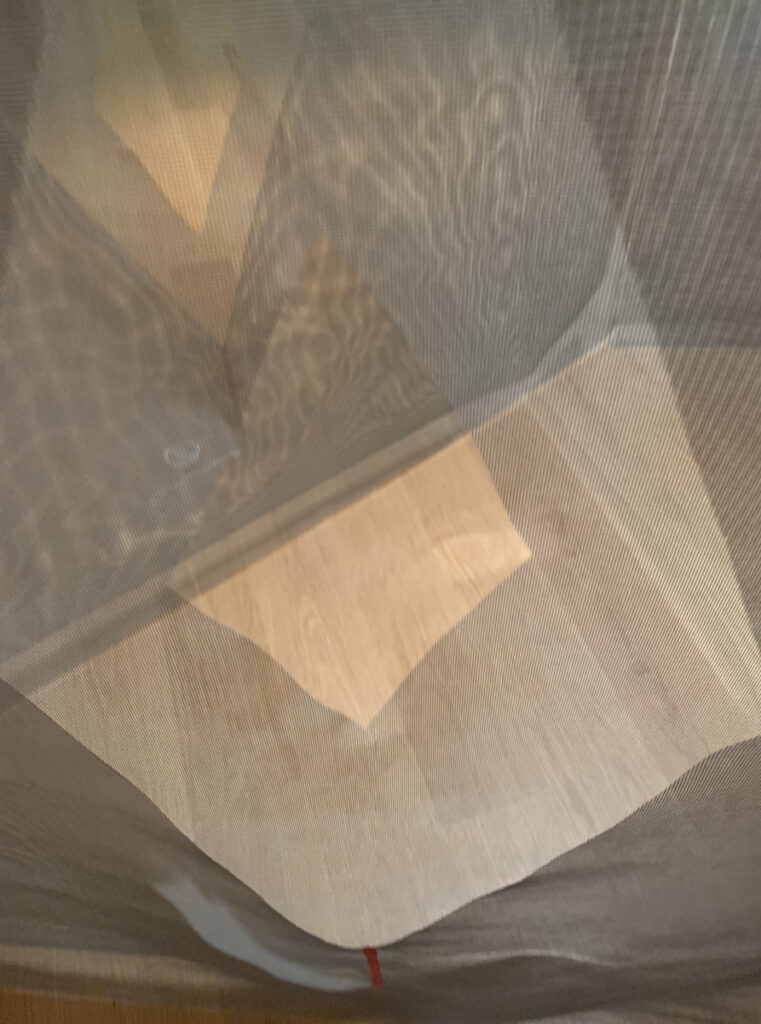
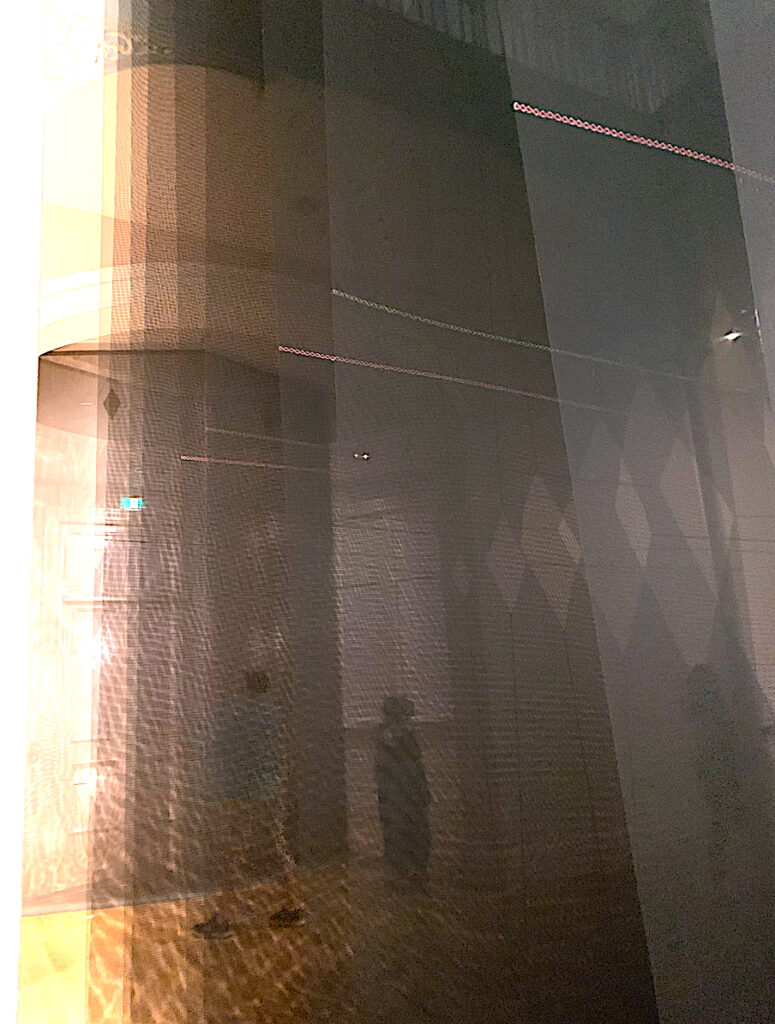
I like how the layers of transparent materials hang with gaps, but seem closed off to living souls. The diamond void could be a window of light, and thus emblematic of the Christian view of God’s light, and the sound of a bird call symbolises Tane: God of the Forest. Hine-titama represented ‘Atapō’ (personification of Dawn), but fled to the underworld and became Hine-nui-te-po (Death / Custodian of souls) after discovering Tane was both her father and husband.
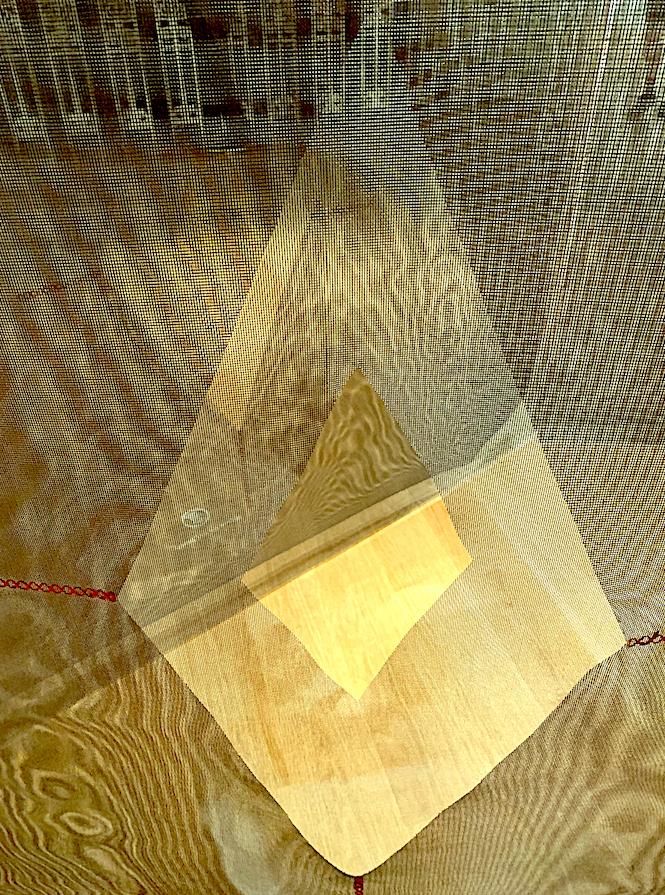
Overall, ‘Atapō’ (personification of Dawn) is an intriguing, collaborative artwork. There are many weighty, heavy and challenging topics and connections, such as Hine-nui-te-po’s myth of incest, which adds a deeper layer of meaning to the purpose of the artwork. A juxtaposition has occurred where the light, transparent materials such as insect mesh, wool, muka and cotton thread have been placed in close proximity to then create a very dense volume of mass. I also saw other layered elemental contrasts such as lines and planes of patterned shapes reflecting and dancing sculptural shadows on the mesh, like flying birds and insects, which created a powerful light quality in comparison to the heavy, dark and apprehensive artwork. Cathy 12.03.21
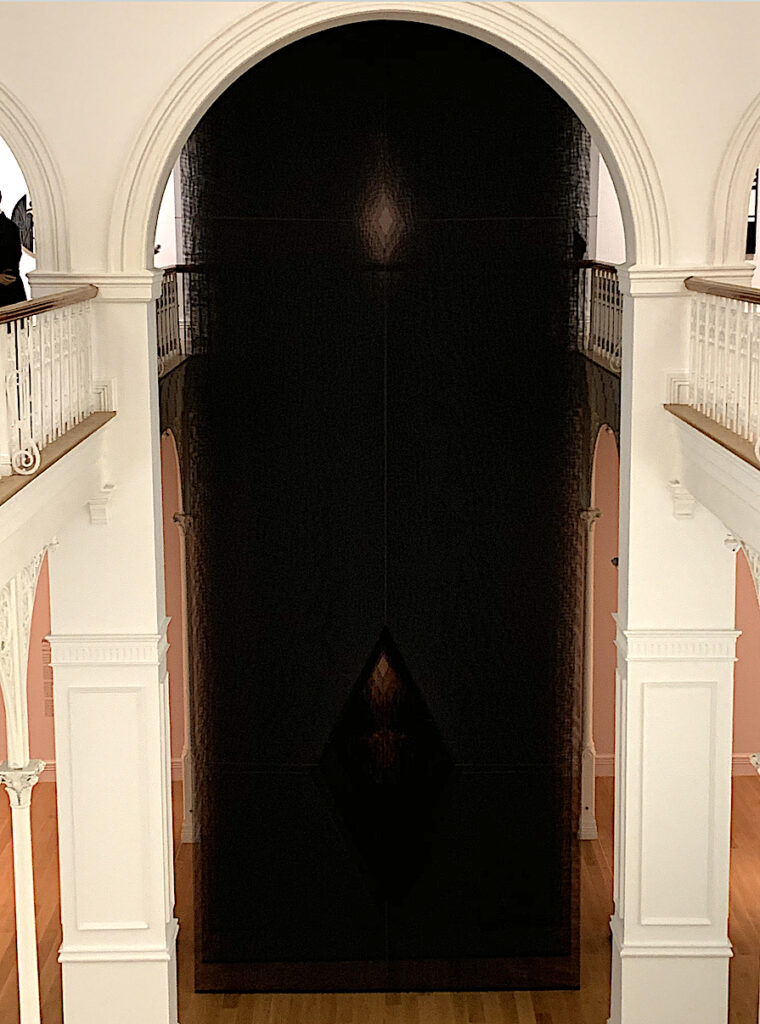
‘A Weight Off Your Mind’ – Choose an Artist that Challenges In the second gallery room, I was particularly attracted to a very traditional artwork by Maureen Lander, yet it was presented in a creative and contemporary fashion as a representation of Marama the moon.
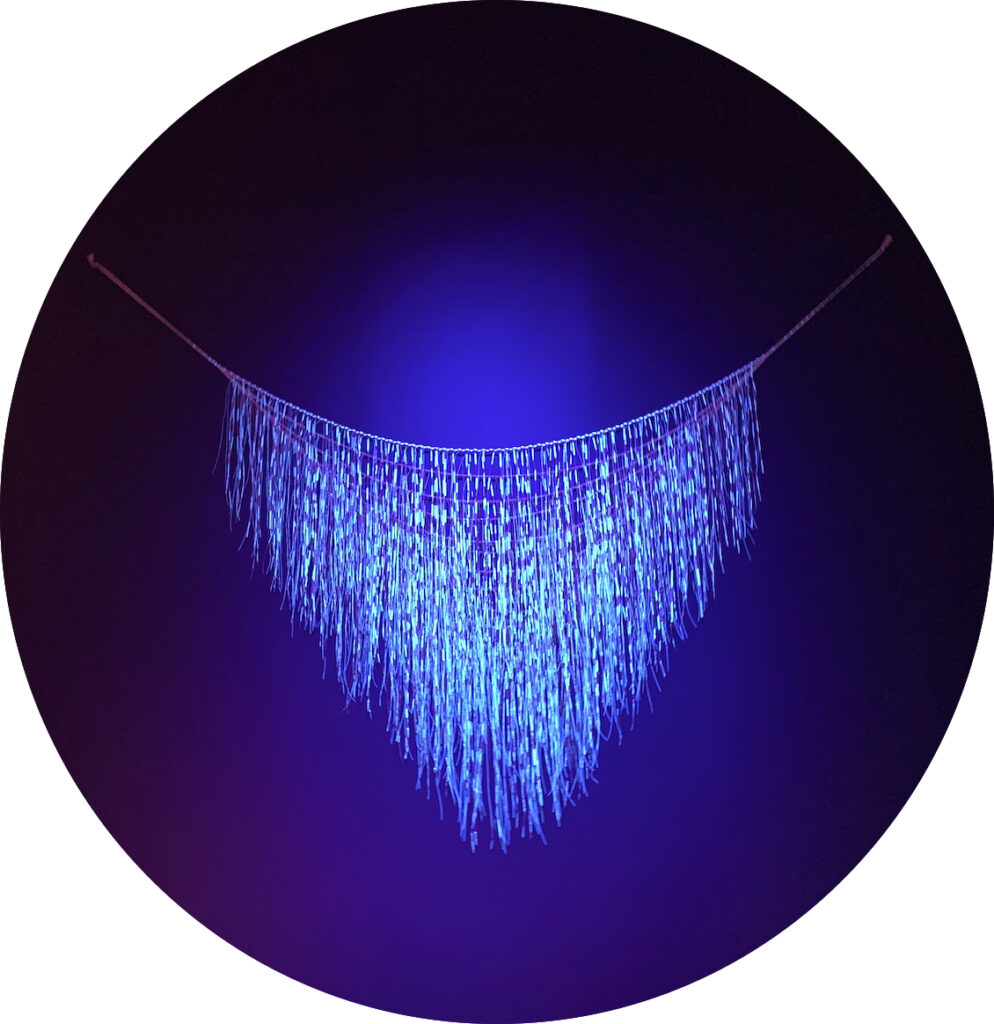
It was challenging to actually see the exact detail, and the real colours of the woven korowai (cloak), as it was placed high up on the wall, out of reach, like the moon.
There was a soft lightweight falling feeling emerging from it, because of the finely delicate weaving that hung vertically. The strong spotlight of fluorescent purply-blue gave the korowai (cloak) a life-force, luminously lighting intricate visual patterns. In contrast, it was a weighty, dense 3-dimensional mass, thick with overlapping strands.
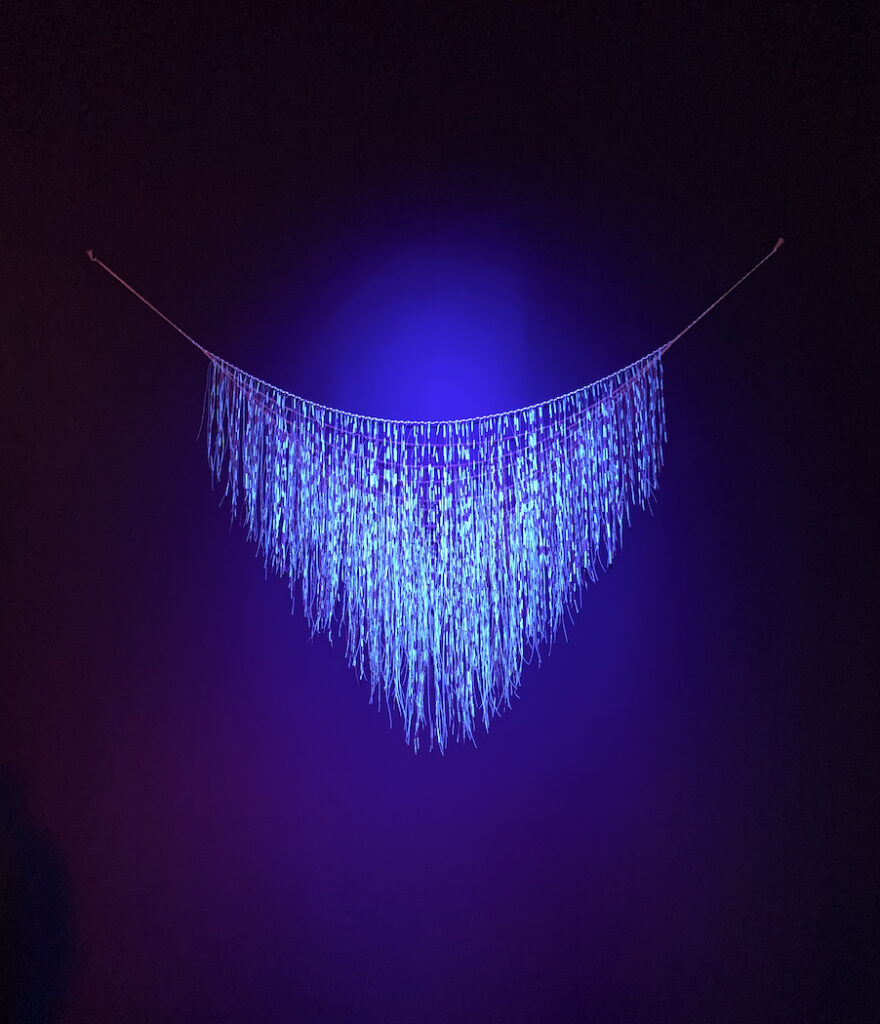
This work may challenge the viewer, because weaving and woven textiles have traditionally been regarded as a craft, and a lower art form from the more traditional fine art disciplines of painting, sculpture and photography. The female craft of raranga (weaving) is now more appreciated. I am pleased that this exhibition (even though it is a showcase for Contemporary Maori art, has been able to share Lander’s traditional woven handiwork. It stretches out on the wall displaying beauty, history, female strength, great mana and prestige. Cathy 12.03.21
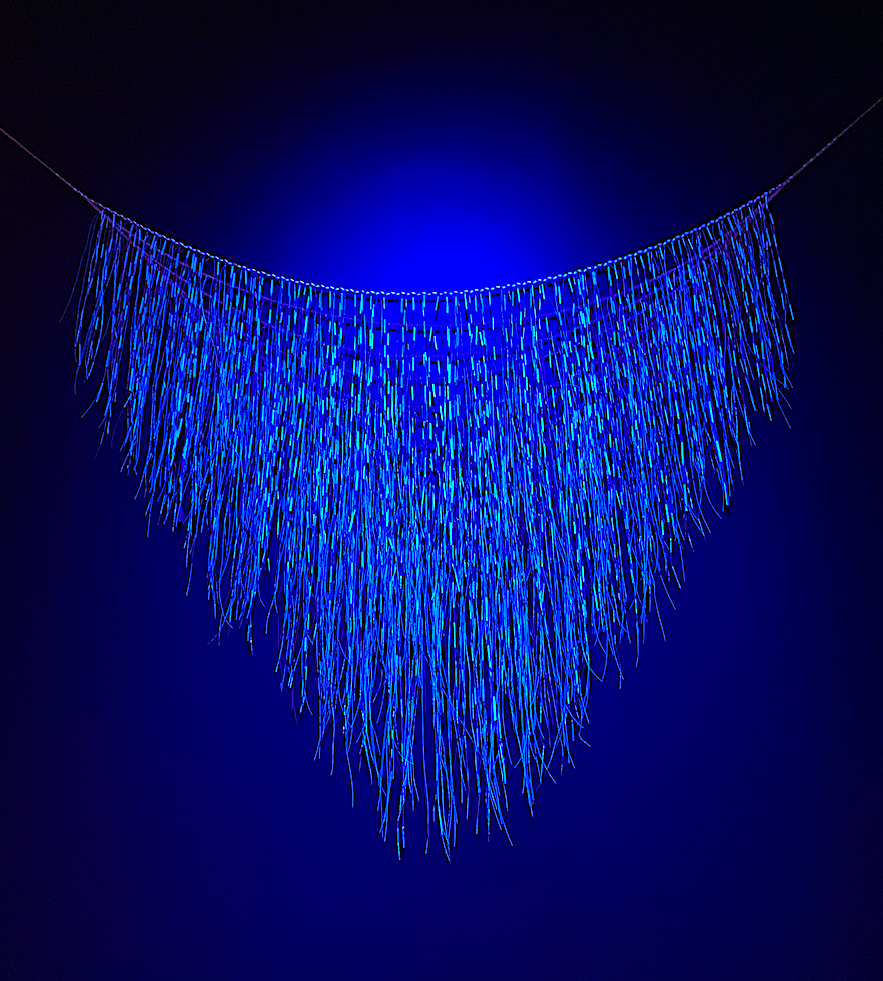
‘A Weight Off Your Mind’ – Choose another Artist that Challenges ‘Waitangi Rosary’ 2007 By Robert Jahnke
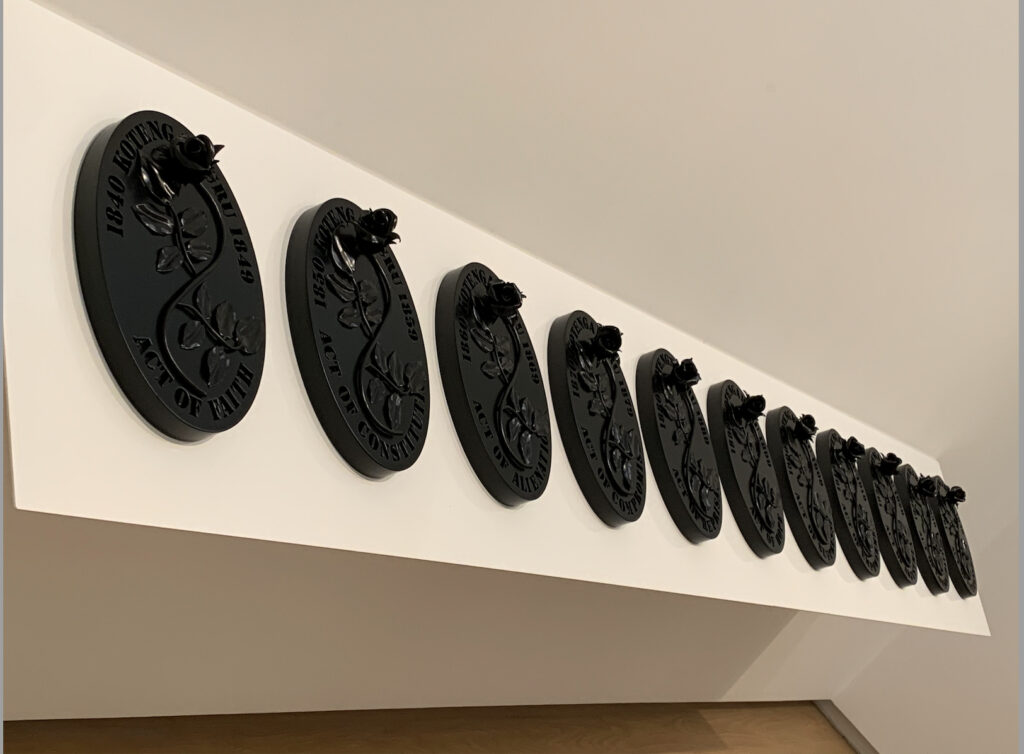
The rosary in Catholicism signifies the remembrance of an important religious or historical event. The rosary beads represent a set of prayers, and the string of beads or knots are touched, and the prayers counted. Robert Jahnke’s artwork titled ‘Waitangi Rosary’ refers to the importance of remembering Aotearoa’s founding document: Te Tiriti o Waitangi, and how significant this historical event is for future race-relations.
Artist Robert Jahnke has laid out in a straight, horizontal line, a set of large oval MDF timber artworks. Moulded and cast in the dangerous metal material of lead that can harm, they seem to lie back on an angle, and float, staring back at the viewer. Covered in a mass of dark, thickly applied black lacquer, their heavy bodies are like enlarged, flattened out rosary beads.
This artwork challenges me, because I find the theme of remembrance, unsolved treaty settlements, and the Principles of the Principles Treaty of Waitangi Deletion Bill, alongside the actual physical plaque-like objects unsettling. Instead of a lighter colour showing an optimistic approach for the future, the objects are shiny, thick, dark and dense, weighted down like paperweights. Their black colour, and rose symbols are solemn, ceremonial, and death-like. They could represent a 17th, 18th or 19th century funeral brooch that is centrally placed on a black mourning dress. Within the volume of each oval piece, black roses project forward like a reverse paper embossment.
I acknowledge Jahnke’s work has a number of meanings, and a play on words. These oval objects are powerful with their visual language, symbols and text, leaving me slightly sombre, instead of a peaceful and contemplative state of remembrance. Cathy 12.03.21
